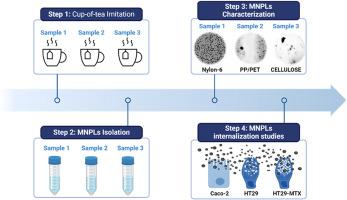Teabag-derived micro/nanoplastics (true-to-life MNPLs) as a surrogate for real-life exposure scenarios
IF 8.1
2区 环境科学与生态学
Q1 ENVIRONMENTAL SCIENCES
引用次数: 0
Abstract
The potential health implications of environmental micro/nanoplastics (MNPLs) are increasingly concerning. Beyond environmental exposure, other sources such as food packaging, including herbal/teabags, may also be significant. This study investigates the release of MNPLs from three commercially available teabags. By simulating tea preparation, MNPL samples were extracted and characterized using a range of analytical techniques: scanning electron microscopy (SEM), transmission electron microscopy (TEM), attenuated total reflectance/Fourier transform infrared spectroscopy (ATR-FTIR), dynamic light scattering (DLS), laser Doppler velocimetry (LDV), and nanoparticle tracking analysis (NTA). The results confirmed that the teabags were made of nylon-6 (NY6), polypropylene (PP), and cellulose (CL) and that microfibers and nano-range particles (NPLs) were present in the leachates. NTA data revealed that the number of released NPLs was 1.20 × 109/mL (PP; 136.7 nm), 1.35 × 108/mL (CL; 244 nm), and 8.18 × 106/mL (NY6; 138.4). The leachate particles were then stained with iDye Poly-Pink and used to expose three human intestine-derived cell types (Caco-2, HT29, and HT29-MTX) to assess their biointeractions and the role of the mucosubstances in vitro. The results demonstrated that after 24 h of exposure to 100 μg/mL NPLs, there was significant uptake of PP-NPLs in HT29-MTX cells, as a model of cells segregating high amount of mucus. A similar uptake was observed for CL-NPLs in HT29 and HT29-MTX cells, while NY6-NPLs were internalized preferentially in Caco-2 cells. These findings underscore the importance of identifying new environmentally relevant MNPL exposure sources, for developing realistic MNPLs samples, and further investigating their potential human health effects.

将茶包衍生的微/纳米塑料(真实的 MNPLs)作为现实生活中暴露情景的替代物。
环境微塑料/纳米塑料(MNPLs)对健康的潜在影响越来越令人担忧。除了环境暴露外,其他来源(如食品包装,包括草药/茶叶袋)也可能是重要来源。本研究调查了三种市售茶包中 MNPLs 的释放情况。通过模拟茶叶制备过程,提取了 MNPL 样品,并使用一系列分析技术对其进行了表征:扫描电子显微镜 (SEM)、透射电子显微镜 (TEM)、衰减全反射/傅立叶变换红外光谱 (ATR-FTIR)、动态光散射 (DLS)、激光多普勒测速仪 (LDV) 和纳米颗粒跟踪分析 (NTA)。结果证实,茶叶袋由尼龙-6(NY6)、聚丙烯(PP)和纤维素(CL)制成,浸出液中存在微纤维和纳米范围颗粒(NPL)。NTA 数据显示,释放的 NPL 数量分别为 1.20x109/mL(聚丙烯;136.7 纳米)、1.35x108/mL(纤维素;244 纳米)和 8.18x106/mL(NY6;138.4 纳米)。然后用 iDye Poly-Pink 对浸出液颗粒进行染色,并将其用于暴露三种人类肠源性细胞类型(Caco-2、HT29 和 HT29-MTX),以评估它们的生物相互作用以及粘液物质在体外的作用。结果表明,HT29-MTX细胞作为分离大量粘液的细胞模型,在接触100微克/毫升NPLs 24小时后,对PP-NPLs有明显的吸收。在 HT29 和 HT29-MTX 细胞中也观察到了类似的 CL-NPLs 吸收,而在 Caco-2 细胞中 NY6-NPLs 被优先内化。这些发现强调了确定新的与环境相关的 MNPL 暴露源、开发真实的 MNPLs 样品以及进一步研究其对人类健康的潜在影响的重要性。
本文章由计算机程序翻译,如有差异,请以英文原文为准。
求助全文
约1分钟内获得全文
求助全文
来源期刊

Chemosphere
环境科学-环境科学
CiteScore
15.80
自引率
8.00%
发文量
4975
审稿时长
3.4 months
期刊介绍:
Chemosphere, being an international multidisciplinary journal, is dedicated to publishing original communications and review articles on chemicals in the environment. The scope covers a wide range of topics, including the identification, quantification, behavior, fate, toxicology, treatment, and remediation of chemicals in the bio-, hydro-, litho-, and atmosphere, ensuring the broad dissemination of research in this field.
 求助内容:
求助内容: 应助结果提醒方式:
应助结果提醒方式:


